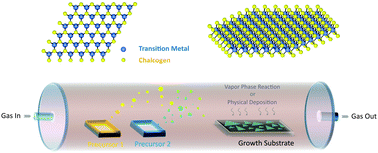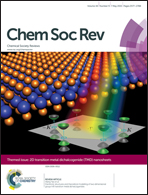Recent advances in controlled synthesis of two-dimensional transition metal dichalcogenides via vapour deposition techniques
Abstract
In recent years there have been many breakthroughs in two-dimensional (2D) nanomaterials, among which the transition metal dichalcogenides (TMDs) attract significant attention owing to their unusual properties associated with their strictly defined dimensionalities. TMD materials with a generalized formula of MX2, where M is a transition metal and X is a chalcogen, represent a diverse and largely untapped source of 2D systems. Semiconducting TMD monolayers such as MoS2, MoSe2, WSe2 and WS2 have been demonstrated to be feasible for future electronics and optoelectronics. The exotic electronic properties and high specific surface areas of 2D TMDs offer unlimited potential in various fields including sensing, catalysis, and energy storage applications. Very recently, the chemical vapour deposition technique (CVD) has shown great promise to generate high-quality TMD layers with a scalable size, controllable thickness and excellent electronic properties. Wafer-scale deposition of mono to few layer TMD films has been obtained. Despite the initial success in the CVD synthesis of TMDs, substantial research studies on extending the methodology open up a new way for substitution doping, formation of monolayer alloys and producing TMD stacking structures or superlattices. In this tutorial review, we will introduce the latest development of the synthesis of monolayer TMDs by CVD approaches.

- This article is part of the themed collection: 2D Transition Metal Dichalcogenide (TMD) Nanosheets

 Please wait while we load your content...
Please wait while we load your content...